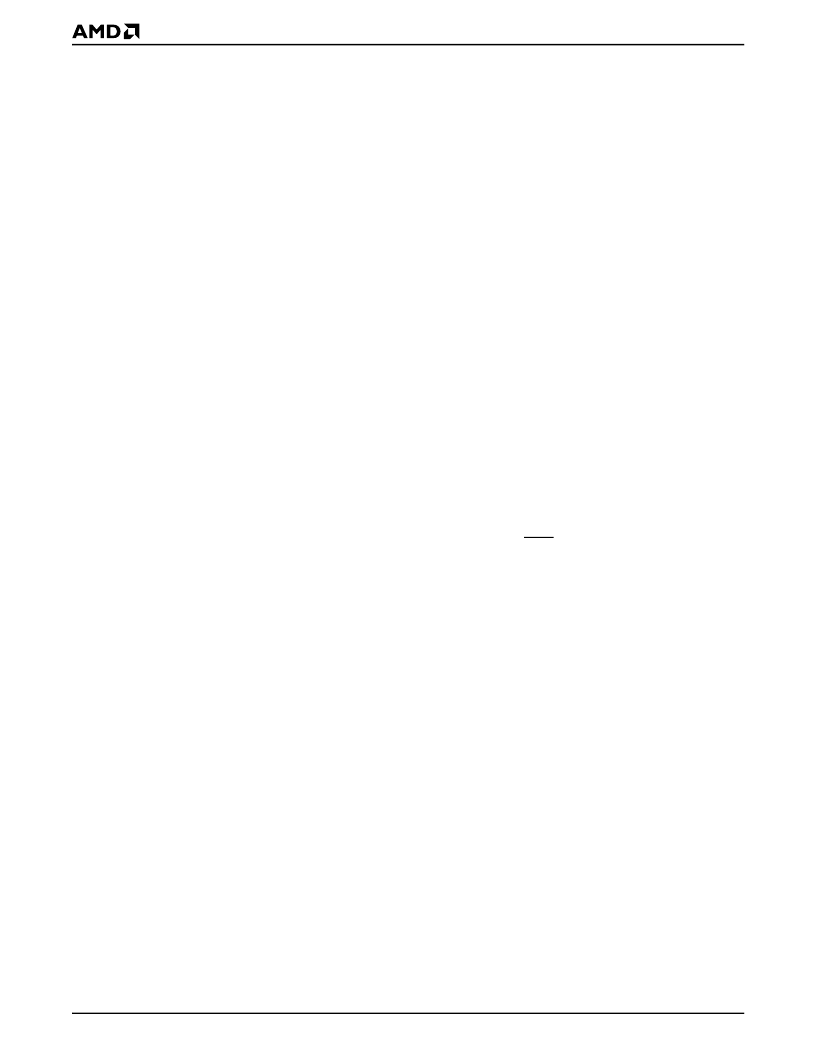- 您現(xiàn)在的位置:買賣IC網(wǎng) > PDF目錄366551 > AM79C978 (Advanced Micro Devices, Inc.) Single-Chip 1/10 Mbps PCI Home Networking Controller PDF資料下載
參數(shù)資料
| 型號: | AM79C978 |
| 廠商: | Advanced Micro Devices, Inc. |
| 英文描述: | Single-Chip 1/10 Mbps PCI Home Networking Controller |
| 中文描述: | 單芯片的1 / 10 Mbps的家庭網(wǎng)絡(luò)控制器的PCI |
| 文件頁數(shù): | 70/261頁 |
| 文件大?。?/td> | 3803K |
| 代理商: | AM79C978 |
第1頁第2頁第3頁第4頁第5頁第6頁第7頁第8頁第9頁第10頁第11頁第12頁第13頁第14頁第15頁第16頁第17頁第18頁第19頁第20頁第21頁第22頁第23頁第24頁第25頁第26頁第27頁第28頁第29頁第30頁第31頁第32頁第33頁第34頁第35頁第36頁第37頁第38頁第39頁第40頁第41頁第42頁第43頁第44頁第45頁第46頁第47頁第48頁第49頁第50頁第51頁第52頁第53頁第54頁第55頁第56頁第57頁第58頁第59頁第60頁第61頁第62頁第63頁第64頁第65頁第66頁第67頁第68頁第69頁當(dāng)前第70頁第71頁第72頁第73頁第74頁第75頁第76頁第77頁第78頁第79頁第80頁第81頁第82頁第83頁第84頁第85頁第86頁第87頁第88頁第89頁第90頁第91頁第92頁第93頁第94頁第95頁第96頁第97頁第98頁第99頁第100頁第101頁第102頁第103頁第104頁第105頁第106頁第107頁第108頁第109頁第110頁第111頁第112頁第113頁第114頁第115頁第116頁第117頁第118頁第119頁第120頁第121頁第122頁第123頁第124頁第125頁第126頁第127頁第128頁第129頁第130頁第131頁第132頁第133頁第134頁第135頁第136頁第137頁第138頁第139頁第140頁第141頁第142頁第143頁第144頁第145頁第146頁第147頁第148頁第149頁第150頁第151頁第152頁第153頁第154頁第155頁第156頁第157頁第158頁第159頁第160頁第161頁第162頁第163頁第164頁第165頁第166頁第167頁第168頁第169頁第170頁第171頁第172頁第173頁第174頁第175頁第176頁第177頁第178頁第179頁第180頁第181頁第182頁第183頁第184頁第185頁第186頁第187頁第188頁第189頁第190頁第191頁第192頁第193頁第194頁第195頁第196頁第197頁第198頁第199頁第200頁第201頁第202頁第203頁第204頁第205頁第206頁第207頁第208頁第209頁第210頁第211頁第212頁第213頁第214頁第215頁第216頁第217頁第218頁第219頁第220頁第221頁第222頁第223頁第224頁第225頁第226頁第227頁第228頁第229頁第230頁第231頁第232頁第233頁第234頁第235頁第236頁第237頁第238頁第239頁第240頁第241頁第242頁第243頁第244頁第245頁第246頁第247頁第248頁第249頁第250頁第251頁第252頁第253頁第254頁第255頁第256頁第257頁第258頁第259頁第260頁第261頁

70
Am79C978
Transmit FCS Generation
Automatic generation and transmission of FCS for a
transmit frame depends on the value of DXMTFCS
(CSR15, bit 3). If DXMTFCS is cleared to 0, the trans-
mitter will generate and append the FCS to the trans-
mitted frame. If the automatic padding feature is
invoked (APAD_XMT is set in CSR4), the FCS will be
appended by theAm79C978 controller regardless of
the state of DXMTFCS or ADD_FCS (TMD1, bit 29).
Note that the calculated FCS is transmitted most signif-
icant bit first. The default value of DXMTFCS is 0 after
H_RESET.
ADD_FCS (TMD1, bit 29) allows the automatic gener-
ation and transmission of FCS on a frame-by-frame
basis. DXMTFCS should be cleared to 0 in this mode.
To generate FCS for a frame, ADD_FCS must be set in
all descriptors of a frame (STP is set to 1). Note that bit
29 of TMD1 has the function of ADD_FCS if SWSTYLE
(BCR20, bits 7-0) is programmed to 0, 2, or 3.
Transmit Exception Conditions
Exception conditions for frame transmission fall into
two distinct categories: those conditions which are the
result of normal network operation, and those which
occur due to abnormal network and/or host related
events.
Normal events which may occur and which are handled
autonomously by theAm79C978 controller include col-
lisions within the slot time with automatic retry.
TheAm79C978 controller will ensure that collisions
which occur within 512 bit times from the start of trans-
mission (including preamble) will be automatically re-
tried with no host intervention. The transmit FIFO
ensures this by guaranteeing that data contained within
the FIFO will not be overwritten until at least 64 bytes
(512 bits) of preamble plus address, length, and data
fields have been transmitted onto the network without
encountering a collision. Note that if DRTY (CSR15, bit
5) is set to 1 or if the network interface is operating in
full-duplex mode, no collision handling is required, and
any byte of frame data in the FIFO can be overwritten
as soon as it is transmitted.
If 16 total attempts (initial attempt plus 15 retries) fail,
theAm79C978 controller sets the RTRY bit in the cur-
rent transmit TDTE in host memory (TMD2), gives up
ownership (resets the OWN bit to 0) for this frame, and
processes the next frame in the transmit ring for trans-
mission.
Abnormal network conditions include:
Loss of carrier
Late collision
SQE Test Error (does not apply to 100 Mbps net-
works.)
These conditions should not occur on a correctly con-
figured IEEE 802.3 network operating in half-duplex
mode. If they do, they will be reported. None of these
conditions will occur on a network operating in full-
duplex mode. (See the section
Full-Duplex Operation
for more detail.)
When an error occurs in the middle of a multi-buffer
frame transmission, the error status will be written in the
current descriptor. The OWN bit(s) in the subsequent
descriptor(s) will be cleared until the STP (the next
frame) is found.
Loss of Carrier
LCAR will be reported for every frame transmitted if
theAm79C978 controller detects a loss of carrier.
Late Collision
A late collision will be reported if a collision condition
occurs after one slot time (512 bit times) after the trans-
mit process was initiated (first bit of preamble com-
menced). TheAm79C978 controller will abandon the
transmit process for that frame, set Late Collision
(LCOL) in the associated TMD2, and process the next
transmit frame in the ring. Frames experiencing a late
collision will not be retried. Recovery from this condi-
tion must be performed by upper layer software.
SQE Test Error
If the network port is in Link Fail state, CERR will be
asserted in the 10BASE-T mode after transmit. CERR
will never cause INTA to be activated. It will, however,
set the ERR bit CSR0.
Receive Operation
The receive operation and features of theAm79C978
controller are controlled by programmable options.
TheAm79C978 controller offers a large receive FIFO to
provide frame buffering for increased system latency,
automatic flushing of collision fragments (runt packets),
automatic receive pad stripping, and a variety of ad-
dress match options.
Receive Function Programming
Automatic pad field stripping is enabled by setting the
ASTRP_RCV bit in CSR4. This can provide flexibility in
the reception of messages using the IEEE 802.3 frame
format.
All receive frames can be accepted by setting the
PROM bit in CSR15. Acceptance of unicast and broad-
cast frames can be individually turned off by setting the
DRCVPA or DRCVBC bits in CSR15. The Physical Ad-
dress register (CSR12 to CSR14) stores the address
that theAm79C978 controller compares to the destina-
tion address of the incoming frame for a unicast ad-
dress match. The Logical Address Filter register
(CSR8 to CSR11) serves as a hash filter for multicast
address match.
相關(guān)PDF資料 |
PDF描述 |
|---|---|
| AM79C981 | Integrated Multiport Repeater Plus⑩ (IMR+⑩) |
| AM79C981JC | Integrated Multiport Repeater Plus⑩ (IMR+⑩) |
| AM79C982 | basic Integrated Multiport Repeater (bIMR) |
| AM79C982-4JC | basic Integrated Multiport Repeater (bIMR) |
| AM79C982-8JC | basic Integrated Multiport Repeater (bIMR) |
相關(guān)代理商/技術(shù)參數(shù) |
參數(shù)描述 |
|---|---|
| AM79C978A | 制造商:AMD 制造商全稱:Advanced Micro Devices 功能描述:Single-Chip 1/10 Mbps PCI Home Networking Controller |
| AM79C978AKC\\W | 制造商:Advanced Micro Devices 功能描述: |
| AM79C978AKC\W | 制造商:Advanced Micro Devices 功能描述: |
| AM79C978AKCW | 制造商:AMD 制造商全稱:Advanced Micro Devices 功能描述:Single-Chip 1/10 Mbps PCI Home Networking Controller |
發(fā)布緊急采購,3分鐘左右您將得到回復(fù)。